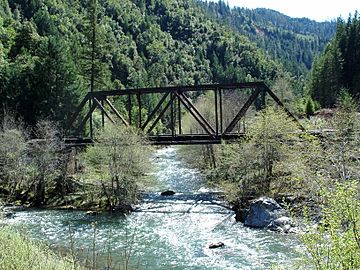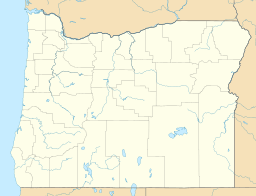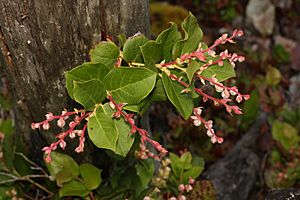Southern Oregon Coast Range facts for kids
Quick facts for kids Southern Oregon Coast Range |
|
|---|---|

Cow Creek, a tributary of the South Umpqua River
|
|
| Highest point | |
| Peak | Bone Mountain |
| Elevation | 3,540 ft (1,080 m) |
| Dimensions | |
| Length | 55 mi (89 km) North-South |
| Geography | |
| Country | United States |
| Parent range | Oregon Coast Range, Pacific Coast Ranges |
| Geology | |
| Age of rock | Paleocene and Eocene |
| Type of rock | volcanic and forearc basin |
The Southern Oregon Coast Range is a group of mountains in the southwest part of Oregon, United States. It is the most southern part of the larger Oregon Coast Range. This mountain range stretches for about 55 miles (89 kilometers). It sits between the Umpqua River and the middle fork of the Coquille River. To the east, you'll find the Umpqua Valley, and to the west is the Pacific Ocean. The tallest peak in this range is Bone Mountain, which reaches about 3,547 feet (1,081 meters) high. People in the Roseburg area sometimes call these mountains the Callahan Mountains.
Contents
How the Southern Oregon Coast Range Formed
The Southern Oregon Coast Range started forming over 60 million years ago. Scientists believe it began as a chain of islands in the ocean. These islands slowly moved and crashed into the North American continent. The oldest parts of this range are called the Roseburg Volcanics. They formed about 64 million years ago from ancient volcanoes.
This area is part of something called a forearc basin. This is a deep area that forms in front of a chain of volcanoes. Over millions of years, this basin has slowly turned about 51 degrees. Many of the mountains are made of pillow basalt. This rock formed when lava cooled quickly underwater. Later, these rock formations were pushed up when the plates collided. Other features, like valleys and riverbeds, were carved out by erosion from water and weather.
Animals and Plants of the Southern Oregon Coast Range
The Oregon Coast Range is home to many different kinds of animals. You can find over 50 types of mammals here. More than 100 kinds of birds also live in these mountains. Nearly 30 types of reptiles and amphibians spend much of their lives here too.
Bird Life Cycle in the Mountains
Many birds make their homes in the Southern Coast Range. You might see large birds like northern goshawks and peregrine falcons. Smaller birds include pileated woodpeckers, olive-sided flycatchers, and western bluebirds. The northern spotted owl, which is a protected species, also lives in these forests.
Aquatic Animals and Their Habitats
The rivers and streams are full of life. You can find fish like river lamprey, Pacific lamprey, and coastal cutthroat trout. Other fish include Millicoma longnose dace and Umpqua chub. Coho salmon and Chinook salmon also swim in these waters. Frogs like red-legged frogs and southern seep salamanders live here too. Western pond turtles are another common sight.
Mammals and Other Wildlife
The forests are home to many mammals. You might spot fringed myotis bats and long-legged myotis bats. Townsend's big-eared bats also live here. Larger animals include fishers and Roosevelt elk. Smaller creatures like shrews, moles, and deer mice are also common. Northern flying squirrels and red tree voles live among the trees.
Plant Life and Forests
The mountains are covered in thick forests. You'll find many Douglas-fir trees and western hemlock forests. Cedar trees are also common. Some parts of these forests are old-growth stands. This means the trees are very old and have not been cut down. Other plants include Sitka spruce, salmonberry, salal, tanoak, and western azalea. Part of the range is within the Elliott State Forest.
Location and Climate of the Range
The Southern Oregon Coast Range starts near the Umpqua River. To the north, it connects with the Central Oregon Coast Range. Oregon Route 38 is generally the line that divides these two sections. To the south, the middle fork of the Coquille River marks the end of the range. Beyond this river are the Klamath Mountains.
Weather Patterns in the Mountains
The climate here is known as a mild maritime climate. This means it has cool, dry summers. The winters are mild and wet. Most of the rain falls during the winter months. Snow can fall at higher elevations during winter. The amount of rain changes from 60 to 120 inches (1,500 to 3,000 mm) each year. Higher elevations get more rain. In January, the average high temperature is about 36.3°F (2.4°C). In July, the average high is around 61.9°F (16.6°C). Temperatures also change depending on how high up you are.
Tallest Peaks in the Southern Oregon Coast Range
All the main peaks in this range are over 3,000 feet (914 meters) high.
| Mountain name | Elevation | County | |
|---|---|---|---|
| feet | metres | ||
| Bone Mountain | 3,547 | 1,081 | Coos |
| Kenyon Mountain | 3,300 | 1,006 | Coos |
| Buzzard Rock | 3,051 | 930 | Douglas |
| Bear Mountain | 3,031 | 924 | Douglas |
Rivers Flowing from the Mountains
Several important rivers start in the Southern Oregon Coast Range. Some of these rivers flow directly to the Pacific Ocean.
- Drains to Pacific Ocean:




